11.1: Introduction to APA Style
11.1.1: When to Use APA Style
APA style, which is based on the American Psychological Association style manual, is widely used in many forms of academic writing.
Learning Objective
Recognize when to use APA style in writing
Key Points
- APA style is one of the most common citation and formatting styles you will encounter in your academic career.
- APA style is based on the style guide of the American Psychological Association (APA), officially titled the Publication Manual of the American Psychological Association.
- APA style is not used only in the field of psychology; it is extremely common throughout the social and behavioral sciences.
- APA style provides guidelines for grammar, formatting, and citing your sources.
Key Term
- APA style
-
A common citation and formatting style, used especially often in the social and behavioral sciences.
APA style is one of the most common citation and formatting styles you will encounter in your academic career. Any piece of academic writing can use APA style, from a one-page paper to a full-length book. It is widely used by hundreds of scientific journals and many textbooks. If you are writing a paper for a psychology or sociology class, it is possible that your professor will ask you to write in APA style.
The APA Manual
APA style is based on the style guide of the American Psychological Association (APA), officially titled the Publication Manual of the American Psychological Association. But APA style is not used only in the field of psychology; in fact, it is extremely common throughout the social and behavioral sciences, and somewhat common in other scientific fields, such as medicine.
The most recent version of the APA manual is the sixth edition, second printing (which corrected errors found in the first printing), published in 2009. The sixth edition introduced guidelines for citing online sources and online-access journal articles.
The Purpose of APA Style
The APA style guide aims to accomplish several goals:
- to ensure consistent formatting and presentation of information, for the sake of clarity and ease of navigation;
- to ensure proper attribution of ideas to their original sources, for the sake of intellectual integrity; and
- to provide a clear structural scaffold for an experimental paper, for the sake of scientific rigor.
Grammar and Formatting
APA style includes many basic grammatical rules. For example, APA style does use the Oxford comma, which some other citation styles (e.g., AP style) do not. Other examples include rules about what punctuation should be included inside a quotation and when to use what type of dash.
APA style also has rules about formatting, such as how to use different levels of headers throughout your paper and what size margins you should use.
Citations
APA style also puts forth guidelines for citing your sources—in fact, this is why it is called a “citation style.” For example, APA style has specific rules for what information to include in your References section, how to cite quotations within a paragraph, and how to incorporate block quotations.
The Scientific Method
APA style rules are not limited to grammar and formatting; in fact, it was originally developed as a set of guidelines for writing without bias in the sciences. The guidelines for reducing bias in language have been updated over the years and provide practical guidance for writing about race, ethnicity, age, gender, sexual orientation, and disability status.
APA style provides a roadmap for the structure of a scientific paper that closely mirrors the scientific method, with sections for the Introduction (including your hypothesis), Method, Results, and Discussion.
11.1.2: Overall Structure and Formatting of an APA Paper
Every paper written in APA style has the same basic structural elements.
Learning Objective
Identify the structural elements of an APA paper
Key Points
- An APA paper should include a title page, an abstract, a body, references, and in some cases, a table of contents and/or endnotes.
- There are specific APA guidelines for font (12pt Times or Times New Roman), line spacing (double-spaced), margins (1 inch), indentation, and page numbering.
- When writing an APA paper, be sure to use the Oxford comma, and only use one space following periods.
- Listen to your professor’s specific guidelines if they want you to use a table of contents.
Key Term
- Oxford comma
-
The comma that comes after the second to last item in a list.
Overall Structure of an APA Paper
Your APA paper should include the following basic elements:
- Title page
- (In rare cases) Table of contents
- Abstract
- Body
- References
- (In rare cases) Endnotes
General Formatting Rules
Font
Your paper should be written in 12-point Times or Times New Roman font.
Line Spacing
All text in your paper should be double-spaced.
Margins
All page margins (top, bottom, left, and right) should be 1 inch (or greater, but 1 inch is standard). All text, with the exception of headers, should be left-justified.
Indentation
The first line of every paragraph and footnote should be indented 1 inch (with the exception of the first line of your Abstract, which should begin at the margin).
Page Numbers
Page numbers in Arabic numerals (1, 2, 3…) should appear right-justified in the header of every page, beginning with the number 1 on the title page. Most word-processing programs have the ability to automatically add the correct page number to each page so you don’t have to do this by hand.
General Grammar Rules
The Oxford Comma
The Oxford comma (also called the serial comma) is the comma that comes after the second-to-last item in a series or list. For example:
The UK includes the countries of England, Scotland, Wales, and Northern Ireland.
In the above sentence, the comma immediately after “Wales” is the Oxford comma.
In general writing conventions, whether the Oxford comma should be used is actually a point of fervent debate among passionate grammarians. However, it’s a requirement in APA style, so double-check all your lists and series to make sure you include it!
Capitalization After Colons and Em Dashes
If you have a colon or em dash (—) in the middle of a sentence, and what follows after is an independent clause (i.e., it could be a sentence on its own), the word after the colon or em dash should be capitalized (as though the following sentence were on its own). For example:
There was only one possible explanation: The train had never arrived.
Here, “The train had never arrived” could stand as its own sentence because it is an independent clause (i.e., it has both a subject—the train—and a verb phrase—had never arrived). Therefore, we capitalize its first word following the colon.
However, if we make one small change to this sentence, the rule changes:
There was only one possible
person
to blame: the train conductor.
Here, “the train conductor” cannot stand as its own sentence, so its first word following the colon is not capitalized.
Sentence Spacing
It used to be convention to type two spaces after every period—for example:
“Mary went to the store. She bought some milk. Then she went home.”
This convention was developed when typewriters were in use; the space on a typewriter was quite small, so two spaces were needed to emphasize the end of a sentence. However, typewriters, and therefore this practice, are now obsolete—in fact, using two spaces after sentences is now generally frowned upon. APA style in particular includes an explicit rule to use only single spaces after periods:
“Mary went to the store. She bought some milk. Then she went home.”
A Note on the Table of Contents
Because APA style is so often used for journal articles, which appear as part of a larger body of work, it does not provide guidelines for tables of contents for the individual papers themselves. If your professor asks you to include a table of contents in your paper, they will give you their own guidelines for formatting.
11.2: APA: Structure and Formatting of Specific Elements
11.2.1: APA: Title Page and Running Head
APA papers have a title page and a “running head,” or a line at the top of every page to identify the paper.
Learning Objective
Arrange the title page and running head correctly in an APA paper
Key Points
- Your title page should be double-spaced, just like the rest of your paper. Center the information on the title page horizontally and vertically.
- Your title page should include the title of your paper, your name, and the name of your school.
- The running head is unique to APA style. It makes the paper identifiable without using the name of the author.
Key Term
- running head
-
A header that does not contain the author’s name, so that the paper can be evaluated without bias.
Title Page
Like the rest of your paper, your whole title page should be double-spaced. The following information should be centered horizontally and vertically on the title page:
- on the first line, the full title of your paper
- on the second line, your name
- on the third line, the name of the institution you are affiliated with (e.g., the name of your school)
These elements should not be bolded, underlined, or italicized.
Running Head
The running head is an element unique to APA style. The purpose of the running head is to make the paper identifiable without using the name of the author; this style is commonly used in journal articles, since journals need to be able to evaluate a paper without bias toward the author.
Left-justified in the header (i.e., at the very top) of your title page, you should have the text “Running head:” followed by an abbreviated title of your paper in all caps. This is usually the first several words of your title and cannot exceed 50 characters in length (including spaces). The abbreviated title, still in all caps, should then appear at the same place—left-justified in the header—on every following page of your paper, but without the text “Running head:” preceding it (that should appear only on the title page).
Any word-processing program should allow you to edit the page header so that the same information appears on every page. You will have to change the options so that the first page is different, so you can include the text “Running head:” only on the title page. Your header and footer should appear 0.5 inches from the edge of the page—this is also an option you can change in your word-processing program.
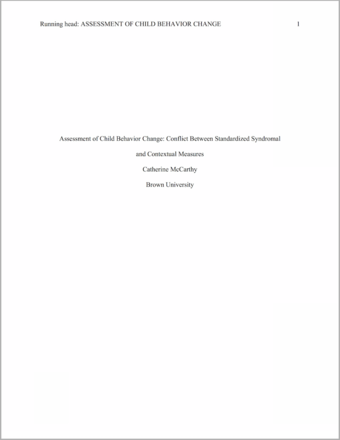
Title page
This is an example of a title page properly formatted in APA style.
11.2.2: APA: Abstract
An APA abstract should summarize your entire paper and should be formatted according to the APA style guide.
Learning Objective
Arrange the abstract correctly in an APA paper
Key Points
- Your abstract should appear by itself on page 2 of your paper; it should be no more than 250 words and should summarize your entire paper.
- The entire abstract should be only one, non-indented paragraph.
- Some abstracts must include keywords.
Key Term
- abstract
-
A brief summary of a paper.
Your abstract should appear by itself on page 2 of your paper. Recall that the running head should now appear left-justified in the header on this page and on every page that follows. (Also recall that, starting on this page, the running head should be only your abbreviated title in all caps, without the words “Running head:” at the beginning.)
Content
Your abstract should be no more than 250 words and should summarize your entire paper, from literature review to discussion.
Formatting
This page should simply be titled “Abstract”; the title should be centered (and not bolded, underlined, or italicized) and should appear in the first line. The abstract itself should start on the following line.
The entire abstract should be only one paragraph, and it is the only paragraph in your paper that is not indented at the beginning—the entire paragraph should be left-justified along the margin.
Any number that appears in the abstract should be written as a numeral (e.g., 1.5, 300) rather than spelled out (e.g., one and a half, three hundred) unless it begins a sentence—then it should be spelled out (e.g., “Three hundred children ate 1.5 sandwiches each”).
Keywords (Optional)
APA style also includes guidelines for providing keywords under your abstract, but this is only required in some situations. If your professor doesn’t mention it, you probably don’t need to include them.
That said, if you do need to include keywords, they should appear on the line immediately after the last line of your abstract. Begin the list with the italicized word “Keywords:”. Then, include a list of 3–10 words or phrases relevant to your paper topic; separate them with commas, and do not end with a period. For example, if you’re writing about people’s experiences of anxiety in stressful situations, you might include the keywords “anxiety” and “stress.”
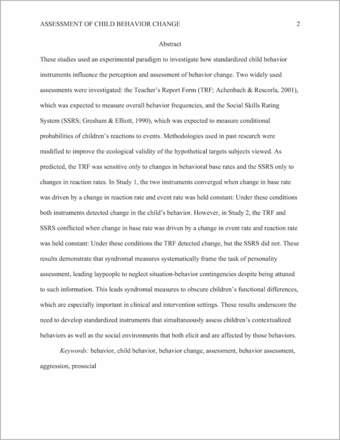
Abstract
This is an example of an abstract properly formatted in APA style.
11.2.3: APA: Headings
In APA style, headings are used to organize your writing and give it a hierarchical organization.
Learning Objective
Order headings correctly in APA style
Key Points
- In APA style, headings are used to organize your writing and give it a hierarchical organization.
- There can be up to five levels of headings in your paper. Some use title case, some use sentence case.
Key Terms
- title case
-
A format in which the first letters of major words are capitalized.
- sentence case
-
A format in which only the first major word (and any proper noun) is capitalized.
In APA style, headings are used to organize your writing and give it a hierarchical organization. This is especially important in papers that present experimental research because they follow the particularly rigid structure of the scientific method.
APA style puts forth specific rules for formatting headings (up to five levels) within your paper:
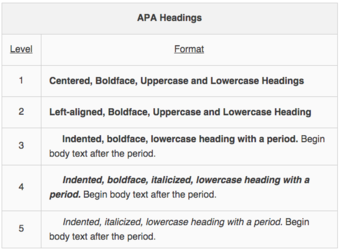
APA heading hierarchy
These are the formatting rules for different levels of headings in APA style.
If a heading is said to be in title case, that means you should format it as though it were the title of a book, with the first letters of most major words capitalized (e.g., A Study of Color-Blindness in Dogs).
If a heading is said to be in sentence case, that means you should format it as though it were a normal sentence, with only the first letter of the first word (and of any proper nouns) capitalized (e.g., A study of color-blindness in dogs).
You should always use heading levels in this order, beginning with Level 1. So, if you have a paper with two levels of headings, you would use Level 1 formatting for the higher level and Level 2 formatting for the lower level. Similarly, if you have a paper with five levels of headings, you would use Level 1 formatting for the highest level and Level 5 formatting for the lowest level.
Your headings should not begin with section numbers (e.g., your Methods section should be titled simply “Methods”, not “2. Introduction”).
The introduction of the paper should not be titled “Introduction”; instead, the paper should simply begin with the title of the entire paper. Note that the “Abstract” title and the overall paper title do not actually count as headings, so they are simply centered and in title case, but not bolded as Level 1 headings would be. This means that the first heading you use in your introduction will follow Level 1 formatting, because it is the first and so at the highest level.
11.2.4: APA: Series and Lists
In APA style, there are specific formats for series and lists.
Learning Objective
Distinguish between correctly formatted lists and series in APA style
Key Points
- If you are including a simple, relatively short list of three to five elements, format it as a “series.”
- If you have more than five elements, or your elements are complex or important, format it as a “list.”
- Use a bulleted list if the order of the atoms doesn’t matter.
- Use a numbered list if the order of the atoms does matter.
Key Terms
- series
-
A simple, relatively short list of three to five items within a paragraph.
- element
-
An item within a series or list.
Series
If you are including a simple, relatively short list of three to five items within a paragraph—also known as a series—the proper formatting is to: (a) precede the list with a comma, (b) label each item with a lowercase letter enclosed in parentheses, and (c) separate each item with commas or semicolons. The items within a series or a list are known as “elements.”
As is standard in most style guides, use semicolons rather than commas to separate the elements of the series if at least one of the elements includes a comma somewhere within it (known as an “internal comma”). For example: “Josie was so hungry she ate: (a) the brownie; (b) the cupcake, wrapper and all; and (c) the bowl of ice cream.” Do not capitalize the first letter of each element (e.g., do not write: (a) The brownie; (b) The cupcake, wrapper and all; and (c) The bowl of ice cream.)
Lists
You will want to use a list rather than a series if any of the following is true:
- you have more than five elements,
- your elements are complex phrases or full sentences, or
- the information is important enough to deserve being visually distinguished from the rest of the text of your paper.
Lists differ from series in that they appear separate from a paragraph rather than embedded within it. However, the same rules of capitalization and of using commas or semicolons to separate the elements apply.
Unlike a series, a list can include elements that are all full sentences, or even paragraphs. If this is the case, each element should end with a period, rather than a comma or semicolon, and should begin with a capital letter.
To better visually distinguish a list from the surrounding text, be sure to leave an extra (blank) line between the last line of the list and the first line of the following paragraph.
Bulleted Lists
You should use a bulleted list if the order of the items doesn’t matter. Each element of the list should start on a new line. The bullet points should be indented one inch from the left page margin, and the text of each element should be indented a further 0.5 inches from the bullet point itself.
Numbered Lists
If the order of your elements does matter—e.g., if you’re outlining a step-by-step process, a summary of how an event unfolded over time, or a series of items in order of importance—you will need to use a numbered list.
As with a bulleted list, each element should start on a new line. The first element should begin with the number 1, the second with the number 2, and so on. These numbers should be followed by periods, and the text of each element should be indented a further 0.5 inches from the beginning number.
11.2.5: APA: Block Quotations
In APA style, format quotations of more than 40 words as block quotations.
Learning Objective
Recognize when to use block quotations in APA style
Key Points
- A typical quotation is part of a sentence within a paragraph in your paper; however, for longer quotations (more than 40 words), format the excerpt as a block quotation.
- A block quotation begins on its own line, is not enclosed in quotation marks, and has its in-text citation after the final punctuation.
- Block quotations are double-spaced, like the rest of your APA paper.
Key Term
- block quotation
-
A way of formatting a particularly long excerpt or quotation in a paper.
When to Use a Block Quotation
A typical quotation is enclosed in double quotation marks and is part of a sentence within a paragraph of your paper. However, if you want to quote more than 40 words from a source, you should format the excerpt as a block quotation, rather than as a regular quotation within the text of a paragraph. Most of the standard rules for quotations still apply, with the following exceptions: a block quotation will begin on its own line, it will not be enclosed in quotation marks, and its in-text citation will come after the ending punctuation, not before it.
For example, if you wanted to quote the entire first paragraph of Lewis Carroll’s Alice in Wonderland, you would begin that quotation on its own line and format it as follows:
Alice was beginning to get very tired of sitting by her sister on the bank, and of having nothing to do: once or twice she had peeped into the book her sister was reading, but it had no pictures or conversations in it, ‘and what is the use of a book,’ thought Alice ‘without pictures or conversations?’ (Carroll, p. 98)
The full reference for this source would then be included in your References section at the end of your paper.
Spacing and Alignment
The entire block quotation should be indented from the left margin the same distance as the first lines of your paragraphs (and the first line should not be further indented). As the rest of your paper, it should be double-spaced. And as with series and lists, to better visually distinguish a block quotation from the surrounding text, be sure to leave an extra (blank) line between the last line of the block quotation and the first line of the following paragraph.
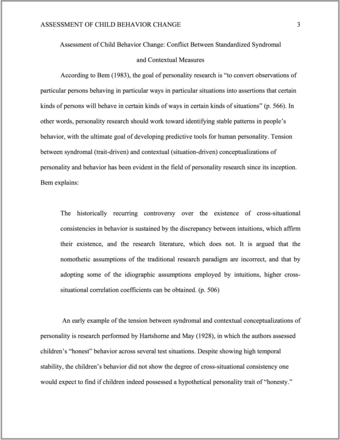
Block quotation
This block quotation is properly formatted in APA style.
11.3: APA: Empirical Research Papers
11.3.1: APA: Reporting Statistics
Because papers using APA style often report experimental data, you must be able to discuss statistics in your paper.
Learning Objective
Identify correctly formatted statistics according to APA style
Key Points
- Since experimental papers in the social sciences are usually written in APA style, you will need to know how to properly talk about statistics in the text of your paper.
- Never never report a statistic in the text of your paper that is already evident in a table or figure, or report a statistic in a table which is reported in your text.
- Always italicize statistical variables.
- Summarize important statistical relationships in clear, plain English.
Key Term
- statistic
-
A numerical figure from experimental data.
Since experimental papers in the social sciences are usually written in APA style, you will need to know how to properly talk about statistics in the text of your paper.
General Rules
You should never mention a statistic in the text of your paper that is already evident in a table or figure, and vice versa.
Be sure to italicize statistical variables (e.g., p-value; t-test, F-test).
Clarity
To place the focus on the meaning of your statistical tests and their relevance to your overall argument, you should summarize each statistical relationship in clear, plain English. Also, include the important values in parentheses, and the test information and significance at the end of the sentence. For example, rather than writing this:
- The mean anxiety score for women was 43.5, and the mean anxiety score for men was 47.9. This difference was significant; a t-test found a t-score of 2.34, and the p-value was 0.01.
You should write this:
- In terms of their scores on the Anxiety Scale, women
were found to be significantly more anxious than men
,
(
stands for “mean”—meaning average—and
stands for “standard deviation.”)
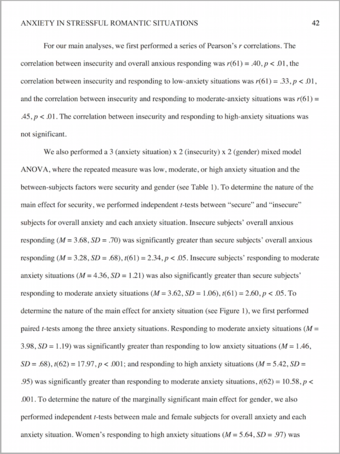
Reporting statistics
This figure shows the proper way to report statistics in an APA-style paper.
11.3.2: APA: Tables and Figures
APA style has specific rules for formatting tables and figures.
Learning Objective
Arrange tables and figures in APA style
Key Points
- APA specifies two methods for presenting information visually: tables and figures.
- A table is a chart that presents numerical information in a grid format.
- A figure, by the APA definition, is generally a graph or visual representation of a process; in rare cases it can also be a photograph.
- Using a table or a figure as a visual aid can help you strengthen a claim you’re making.
When you need to summarize quantitative data, words can only go so far. Sometimes, using a chart, graph, or other visual representation can be useful in proving your point. However, it’s important to make sure you incorporate this extra information in a way that is easy to understand and in line with the conventions of APA style.
APA specifies two methods for representing information visually: tables and figures.
Tables
A table is a chart that presents numerical information in a grid format. APA style recommends that a table be used only for particularly complex data or large data sets; if your table has only one or two columns, you should summarize the information within the text of a paragraph instead.
In APA style, you must include each table on its own separate page at the very end of your paper, after the References section. (Note that these pages should still include the running head and page number.) Because tables are in a separate section, you must refer to each one in the text of your paper by its number (e.g., “Table 1”) so the reader knows where it is relevant.
Formatting
Format your tables as simply as possible. Do not use bold or italicized text (unless you are talking about a variable or statistical test that requires such formatting).
APA style has strict rules about how to format the borders, or the lines, of your table. Generally, for simpler tables, you should have only three horizontal lines: one immediately above and one immediately below the column headings, and one at the bottom of the table.
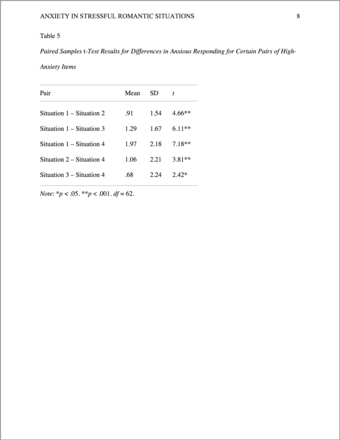
Simple table
This table is properly formatted in APA style, using only three horizontal borders.
If you have a more complex table—e.g., one that has multiple layers of column headers or sections of data—you may sparingly use additional horizontal lines as visual separators.
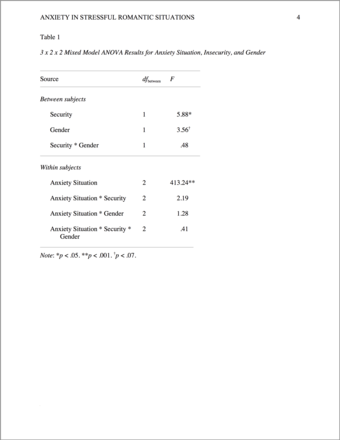
Complicated table
This more complicated table is properly formatted in APA style; it uses more than three horizontal borders to clearly separate the different sections.
Title and Source
Every table should appear flush with the left margin. Immediately above the table, provide its number (e.g., “Table 1”), and then on the next line provide a short but descriptive title in italicized title case.
If your table includes any abbreviations that need defining, or statistics whose significance levels need noting, immediately below the table, write the word “Note” in italics, followed by a colon, and then provide the needed explanation.
If your table comes from another source, you need to add that source to your References section. Using the same formatting, you should also place that information immediately below your table, following the word “Source” in italics.
Figures
In APA style, you must also include each figure on its own separate page at the end of your paper; this section of figures should appear after the section of tables. (Note that these pages should also still include the running head and page number.)
Because figures appear separate from the body of your paper, you must refer to each one in the text of your paper by its number (e.g., “Figure 1”) so the reader knows where it is relevant.
Formatting
APA style has strict rules about how to create and format your figures.
- Any text in a figure (e.g., axis labels, legend labels) should be in a sans-serif font, between 8pt and 14pt in size.
- One-column figures (e.g., a graph with a single panel) should be between 2 and 3.25 inches in width.
- Two-column figures (e.g., a graph with two panels) should be between 4.25 and 6.875 inches in width.

Single-panel figure
This is a single-panel figure properly formatted in APA style.
Title and Caption
Every figure should appear flush with the left margin. Immediately below the figure, provide its number (e.g., “Figure 1”) in italics, followed by a period, followed by a brief but descriptive title (called a “figure caption”) in sentence case. For example:
- Figure 1. Average self-reported anxiety of 18- to 24-year-old women in response to perceived social slight.
If your figure includes any abbreviations that need defining, or statistics whose significance levels need noting, include this information in the figure caption. For example:
- Figure 1. Average self-reported anxiety of 18- to 24-year-old women in response to perceived social slight.
The title of the figure should not appear in the figure itself—it should appear only in the caption beneath the figure.
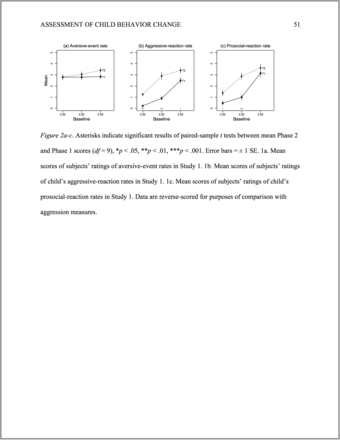
Three-panel figure
This is a three-panel figure properly formatted in APA style.
11.4: APA: Citations and References
11.4.1: APA: The References Section
In APA style, the sources you cite in your paper are listed all together at the end, in the References section.
Learning Objective
Arrange the References section in APA style
Key Points
- In APA style, all the sources you cite throughout the text of your paper are listed together in the References section.
- The References section has its own special formatting rules, including double-spaced text and hanging indentation.
- How you should format each individual citation differs differs slightly based on source type; there are different citation styles for books, online resources, journals, and many others.
Key Term
- hanging indent
-
A formatting style for citations in APA Reference pages in which every line except the first is an inch away from the left margin.
In APA style, all the sources you cite throughout the text of your paper are listed together, and more fully, in the References section, which comes after the main text of your paper.
Formatting the References Section
The top of the page, as the rest of your paper, should still include the running header on the left and the page number on the right. On the first line, the title of the page—“References”—should appear centered and not italicized or bolded. (As is the case with the “Abstract” page title, this does not count as an actual heading, so it is not formatted per the heading guidelines.) And, like the rest of your paper, this page should also be double-spaced.
Starting on the next line after the page title, your references should be listed in alphabetical order by author. Multiple sources by the same author should be listed chronologically by year within the same group.
Each reference should be formatted with what is called a hanging indent. This means the first line of each reference should be flush with the left margin (i.e., not indented), but the rest of that reference should be indented one inch from the left margin. Any word-processing program will let you format this automatically so you don’t have to do it by hand. (In Microsoft Word, for example, you simply highlight your citations, click on the small arrow right next to the word “Paragraph” on the home tab, and in the popup box choose “hanging indent” under the “Special” section. Click OK, and you’re done.)
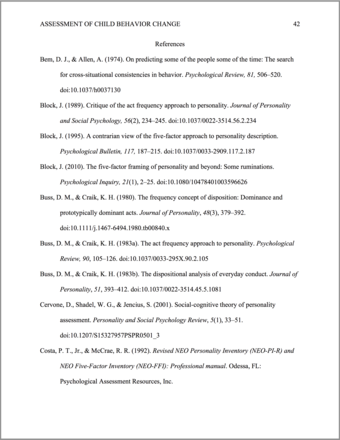
References
This is an example of the first page of a References section properly formatted in APA style.
Constructing a Citation
The first step in building each individual citation is to determine the type of resource you are citing, since in each citation style formatting differs slightly based on source type. Some common types are a book, a chapter from a book, a journal article, an online book or article, an online video, a blog post, and personal communication such as an email or an interview you conducted. (You’ll notice that “website” is not a category by itself. If the information you found is online, you want to determine if you’re looking at an online book, an online article, or some other type of document.)
As an example, let’s look in detail at the process of citing three particular sources in APA style: Joseph Conrad’s Heart of Darkness (i.e., a book by one author), Project Gutenberg’s online text of the same book (i.e., an online book), and an online journal article about the book.
Print Sources
Author Name
You always want to start with the author information. You should present the author information in the following order and format: the author’s last name (capitalized), a comma, the author’s first initial, then a period, and finally their middle initial and period (if given):
- Conrad, J.
Date of Publication
After the author’s name, you provide the year, inside parentheses, in which the source was published, followed by a period. It may look odd, but make sure your period is outside the parentheses.
- (1993).
Title of Source
Next, you should include the title of the source in sentence case. For a book, the title is italicized.
- Heart of darkness.
City of Publication
Next, you want to provide the location of the publisher’s office. The location is generally a city, such as “London” or “New York, NY.”
- London:
Publisher Name
Next, provide the publisher’s name, followed by a period:
- Everyman’s Library.
All together, then, the citation looks like this:
- Conrad, J. (1993). Heart of darkness. London: Everyman’s Library.
Online Sources
Now let’s take a look at the citation for the online version of the same book, available online through Project Gutenberg (gutenberg.org). Much of the citation is the same:
- Conrad, J. (2006). Heart of darkness. Project Gutenberg. Retrieved from https://www.gutenberg.org/files/219/219-h/219-h.htm
Journal Articles and Multiple Authors
- NooriBerzenji, L. S., & Abdi, M. (2013). The image of the Africans in Heart of Darkness and Things Fall Apart. Interdisciplinary Journal of Contemporary Research in Business, 5(4), 710–726.
Much of this citation will look familiar to you now that you know the basics. Again, we start with the author information. This article has multiple authors, so we list them in the same order in which they are listed in the source, and in the same format as before (last name, first initial, middle initial), separated by commas. The last author should also have an “and” sign, or ampersand (&), before it. Here we have only two authors, but if we had five, the ampersand would come before the fifth author’s last name, after the comma following the fourth author’s name.
The date of publication and title are formatted the same. Note that even though APA style says that the article title should not be italicized, the book titles “Heart of Darkness” and “Things Fall Apart” within the article title are still italicized.
The new information here begins with citing the journal this article is from. Include the title of the journal in italicized title case (all major words capitalized, as in the title of a book), followed by a comma:
- Interdisciplinary Journal of Contemporary Research in Business,
Then include the journal volume, also italicized:
- 5
If the particular journal you’re citing lists an issue number in addition to the volume number, as this one does, include it in parentheses immediately after the volume, and do not italicize it. Then follow it with a comma.
- 5(4),
Finally, list the page numbers of the article, followed by a period [note that the dash between the first and second numbers is an en-dash (–), not a hyphen (-) or em-dash (—)]:
- 710–726.
Multiple Publications by the Same Author in the Same Year
If you are referencing multiple publications by the same author (or group of authors) that were published in the same year, there is a special rule for denoting this. You should first order those articles alphabetically by source title in the References section. Then, append a lowercase letter in alphabetical order to the end of each year of publication:
- Achenbach, T. M. (2012a). Bibliography of published studies using the ASEBA. Retrieved March 25, 2012, from Achenbach System of Empirically Based Assessment: http://www.aseba.org/asebabib.html
- Achenbach, T. M. (2012b). School-age (ages 6–18) assessments. Retrieved March 18, 2012, from Achenbach System of Empirically Based Assessment: http://www.aseba.org/schoolage.html
A Note on Capitalization
In the guidelines for citing different types of sources in APA style, you will notice several different patterns in capitalizing source titles. A work that stands on its own—a book, a painting, a film, etc.—should be written in italicized title case (every major word capitalized). A source that is part of a larger work—a chapter in an anthology, an article in a journal, a web page, etc.—should be written in sentence case and not italicized. (Recall that sentence means that just the first word and proper nouns are capitalized, as well as the first word after a colon, if there are any). As an example, compare the citations of Heart of Darkness and the NooriBerzenji & Abdi (2013) article.
11.4.2: APA: How to Reference Different Types of Sources
In APA style, there are different formats for citing sources at the end of your paper depending on the type of source.
Learning Objective
List the ways to cite different source types in APA style
Key Points
- In your References section, you will have to create a citation for every source you used in your paper; these citations will be formatted differently depending on the source type.
- There are different citation styles for books, depending on how many authors they have.
- There are different citation styles for articles, depending on where you found them.
- There are ways to format sources that are not books or articles.
Key Term
- ellipsis
-
A punctuation mark consisting of three periods in a row, used to indicate an omission, a pause, or additional, unmentioned list items.
Now that you know the different components of a book citation in APA style and how they should be formatted, you will be able to understand the citation formats for other source types. Here are some example citations for the most common types of resources you will use.
Book by One Author
Sherman, R. D. (1956). The terrifying future: Contemplating color television. San Diego: Halstead.
Book by Multiple Authors
Two Authors
Kurosawa, J., & Armistead, Q. (1972). Hairball: An intensive peek behind the surface of an enigma. Hamilton, ON: McMaster University Press.
Three to Seven Authors
Brown, T. E., LeMay, H. E., Bursten, B. E., Murphy, C., & Woodward, P. (2011). Chemistry: The central science. London: Prentice Hall.
More than Seven Authors
List the first six authors, then an ellipsis, then the final author.
Hughes-Hallett, D., Gleason, A. M., McCallum, W. G., Lomen, D. O., Lovelock, D., Tecosky-Feldman, J., … Lock, P. F. (2008). Calculus: Single variable. Hoboken, NJ: Wiley.
Article in an Edited Book
Stanz, R. F. (1983). Practical methods for the apprehension and sustained containment of supernatural entities. In G. L. Yeager (Ed.), Paranormal and occult studies: Case studies in application (pp. 42–64). London, England: OtherWorld Books.
Article in a Journal with Continuous Pagination
Rottweiler, F. T., & Beauchemin, J. L. (1987). Detroit and Sarnia: Two foes on the brink of destruction. Canadian/American Studies Journal, 54. 66–146.
Article in a Journal Paginated Separately
Crackton, P. (1987). The Loonie: God’s long-awaited gift to colourful pocket change? Canadian Change, 64(7), 34–37.
Article in an Internet-Only Journal
Blofeld, H. V. (1994, March 1). Expressing oneself through Persian cats and modern architecture. Felines & Felons, 4, Article 0046g. Retrieved October 3, 1999, from http://journals.f+f.org/spectre/vblofeld-0046g.html
Page on a Web Site
Pavlenko, A. (2015, October 7). Bilingual minds, bilingual bodies. Psychology Today. Retrieved from https://www.psychologytoday.com/blog/life-bilingual/201510/bilingual-minds-bilingual-bodies
Page on a Web Site, No Author Identified, No Date
Bilingual minds, bilingual bodies. (n.d.). Psychology Today. Retrieved from https://www.psychologytoday.com/blog/life-bilingual/201510/bilingual-minds-bilingual-bodies
11.4.3: APA: In-Text Citations and Parentheticals
In APA style, there are different formats for citing sources in text depending on the type of source.
Learning Objective
Arrange in-text citations in APA style
Key Points
- In-text citations are where you tell the reader, within the text of your paper, the author’s name and the date the source was published.
- The correct formatting for an in-text citation varies depending on how many authors created the work being cited.
- Formatting also varies depending on whether you cite the same source more than once, or whether you cite multiple works by the same author.
Key Term
- in-text citation
-
Giving the name and year or other identifying information of the author of a source within the text of a paper.
In your paper, when you quote directly from a source in their words, or when you paraphrase someone else’s idea, you need to tell the reader what that source is so the author gets credit for their words and ideas. When you tell the reader the author’s name and the date the source was published in the text of your paper, this is called an in-text citation.
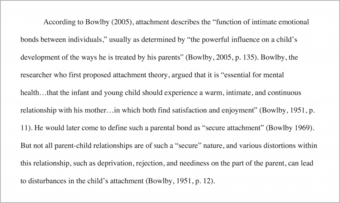
In-text citations
These in-text citations are properly formatted in APA style.
Source by a Single Author
To cite this type of reference in the text, you should use what is known as a parenthetical—the citation information enclosed in parentheses—at the end of the relevant sentence. The parenthetical should include the author’s last name (with no first or middle initial), followed by a comma, followed by the year the source was published. If you’re citing a direct quote, you also need to include the page number. For example:
- Social representations theory posits that reified scientific knowledge that exists at the boundaries of a given society will be interpreted in meaningful and often simplified forms by the majority (Pauling, 2005).
- Social representations theory “proposes a new hypothesis …” (Pauling, 2005, p. 113).
If you choose, you can integrate the author’s name into the sentence itself—this is known as a “signal phrase”—and provide just the year in parentheses:
- Pauling (2005) posits that …
Source by Two Authors
Authors should be presented in the order in which they are listed on the published article. If you include the authors’ names in the parenthetical, use an ampersand (&) between the two names. For example:
- Social representations theory posits that reified scientific knowledge that exists at the boundaries of a given society will be interpreted in meaningful and often simplified forms by the majority (Pauling & Liu, 2005).
If you choose to use a signal phrase instead, use the word “and” rather than an ampersand:
- Pauling and Liu (2005) posit that …
Source by Three to Five Authors
For an article with three to five authors, the first time you cite the article in the text of your paper, you should include the names of all the authors (in the same order in which they appear in the article) followed by the year of publication. After that, to save space and to make your paper easier to read, you should use only the first author’s name followed by “et al.” and the year of publication. (“Et al.” is short for “et alia,” which means “and other people” in Latin—much like “etc.” is short for “et cetera,” which means “and other things” in Latin.)
First Instance
- Social representations theory posits that reified scientific knowledge that exists at the boundaries of a given society will be interpreted in meaningful and often simplified forms by the majority (Pauling, Liu, & Guo, 2005).
Using a signal phrase:
- Pauling, Liu, and Guo (2005) posit …
Subsequent Instances in the Same Document
- (Pauling et al., 2005)
Using a signal phrase:
- Pauling, et al. (2005) posit …
Source by More than Five Authors
For an article with more than five authors, include only the first author’s name followed by “et al.” and the year of publication in each in-text citation.
- (Hughes-Hallett et al., 2008)
Using a signal phrase:
- Hughes-Hallett et al. (2008) claim that …
Multiple Publications by Different Authors
If you need to cite multiple publications by different authors in the same sentence, you should list the multiple sources in alphabetical order by author and use a semicolon to separate them.
- … majority (Alford, 1995; Pauling, 2004; Sirkis, 2003).
If within this citation you also have multiple sources by the same author, after that author’s name separate the multiple dates of publication with a semicolon and order them chronologically (earliest to latest).
- … majority (Alford, 1995; Pauling, 2004; 2005; Sirkis, 2003).
Multiple Publications by the Same Author
If an author has multiple publications which you wish to cite in the same sentence, you use a semi colon (;) to separate the years of publication in chronological order (oldest to most recent).
- … majority (Pauling, 2004; 2005).
Using a signal phrase:
- Pauling (2004; 2005) suggests that …
Multiple Publications by the Same Author/s in the Same Year
If multiple publications by the same author (or group of authors) were published in the same year, there is a special rule for denoting this. In the References section, you would order those articles alphabetically by source title, and then append a lowercase letter in alphabetical order to the end of the year of publication. For example, if you had two publications by Pauling in 2004, the first would be marked as (2004a) and the second as (2004b). You would then include these lowercase letters in your in-text citations as well:
- … majority (Pauling, 2004a; 2004b).
